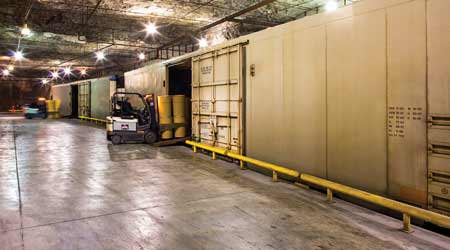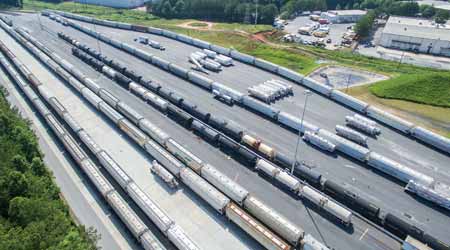Railroad News
Transloading provides railroads with another way to attract business
BNSF provides transloading services at its logistics center in Sweetwater, Texas.Photo – BNSF Railway Co.
By
For U.S. rail traffic, 2016 wasn’t exactly a banner year. Total carloads fell 8.2 percent compared with 2015’s level, marking the second consecutive year of declining traffic, according to data from the Association of American Railroads (AAR).
A weak manufacturing economy and turmoil in energy markets were two of the main reasons for the decline, AAR officials said earlier this year.
With their traffic dwindling among primary money-makers like coal, some Class Is have refocused their efforts on revenue opportunities in other business segments. One of the more promising segments is transloading, which is the transfer of goods from one transportation mode to another to complete a shipment.
BNSF Railway Co. is observing good transloading activity so far this year, with that piece of business outperforming initial forecasts, says Colby Tanner, the railroad’s assistant vice president for economic development. In particular, frac sand and construction materials have been strong performers.
In late 2016, BNSF started seeing an uptick in transloaded wind blades, turbines and other wind energy-related products. That trend has continued strong into this year, Tanner says.
So far this year, the Class I’s overall transloading volumes are increasing over the same point in 2016. Tanner attributes that, in part, to substantially low traffic in general last year. Still, BNSF’s transloading business has been a “very good story” in 2017, he maintains.
Seizing the opportunity
That’s a sentiment echoed by the railroad’s transloading partners. Each year, BNSF holds a meeting at its Fort Worth, Texas, headquarters with companies that received the Class I’s “premier transloader” designation. At the 2017 meeting in May, BNSF execs heard nothing but positive forecasts from those firms, Tanner says.
“Our transload partners are very astute at figuring out where the markets are headed, and getting ahead of that,” Tanner adds. “They’ve done a great job capitalizing on markets that are strong.”
Companies earn the “premier” label by providing consistent, long-term service with BNSF. About 40 percent of the nearly 400 firms in the railroad’s transloading network have received the designation. This year, the Class I has added 15 new premier transloaders.
The premier transloader program provides another way to build new business.
“When we have a transloader that we’ve had good experience with, we want to make sure that new potential customers are aware of those opportunities,” Tanner says.
One company that recently received the designation is Springfield Underground, which provides bulk warehousing services in Springfield, Missouri. Although the company signed its first agreement with BNSF’s predecessor the Frisco railroad in 1946, there hasn’t been as much rail demand in more recent years. However, changes in transportation economics have altered that.

Springfield Underground’s below- and above-ground facilities feature rail connections.
Springfield Underground
“With diesel fuel prices and the shortage of drivers for long-haul trucks, we’ve started to see more interest [in rail service],” says Springfield Underground Chief Operations Officer John Griesemer.
So, the company in 2015 added a switch and 1,000 feet of track to its facility. Springfield Underground has plans to add another 1,000 feet of track this year.
BNSF’s customer integration and online teams played a crucial role in helping Springfield Underground achieve the premier designation.
“They’re interested in your success as a transloader,” Griesemer says. “They’ve bent over backward to educate me on the business.”
When issues have arisen, BNSF’s team have quickly remedied them. For example, after an equipment breakdown, a local operations team jumped in to perform a special switch to keep shipments on schedule.
BNSF also maintains transparency in its transloading operations, Griesemer says.
“There are no secrets as to anything going on with your cars or switch times,” he says.
Last month, BNSF announced another addition to its premier transloader network: Sand Springs Railway Co.’s transloading facility in Tulsa, Oklahoma. As part of the nomination process for the designation, the OmniTRAX Inc. short line’s transload facility was vetted using a survey to determine the freight being moved and the services offered.
Afterward, interviews were held with BNSF’s transload team and a site visit was conducted to verify services.
NS posts gains, too
Meanwhile, better economic conditions have contributed to the growth of Norfolk Southern Railway’s transloading business, as well. The Class I provides transloading services through its Thoroughbred Bulk Transfer (TBT) facilities, which are used to transload 80 to 90 different commodities.
In 2016, TBT’s volume was up 4 percent compared with 2015’s mark. And through May of this year, the subsidiary’s volume rose 2.7 percent compared with the same period in 2016.
“An improving economy has contributed to the growth at TBT facilities, as have efforts by shippers to reduce last-mile truck costs,” said NS Senior Manager of Distribution Services Baird Spicuzza in an email.

Norfolk Southern Railway’s Thoroughbred Bulk Transfer Facility in Doraville, Georgia, was expanded in recent years.
Norfolk Southern Railway
In addition, NS’ new, expanded or improved TBT facilities have contributed to incremental volume growth. The Class I picked up two transloading facilities as part of its 2015 purchase of the former Delaware & Hudson line from Canadian Pacific: one in Binghamton, New York, and the other in Taylor, Pennsylvania.
The railroad also repurposed four former Triple Crown facilities into transloading sites in Indiana, Georgia, Missouri and Ohio.
In total, NS has opened seven TBT facilities over the past two-and-a-half years. During that same period, the Class I expanded one facility in Doraville, Georgia, and improved others in Michigan, New Jersey, Virginia and West Virginia.
In addition to opening new transload sites, NS has added spill containment areas at several TBT facilities.
“One of the biggest trends in the transload market is growth in commodities that require spill containment,” Spicuzza explained.
Another ongoing trend is the ethanol market. Over the past year, the commodity has remained a strong part of NS’ TBT portfolio, along with other agricultural products and plastics. Roughly half of NS’ overall TBT volumes are agricultural products.
And although there aren’t many game-changer growth opportunities in the transload market, there’s plenty of room for incremental growth across many commodities, Spicuzza said. One opportunity is anthracite coal, which is used as a carbon additive in steelmaking.
“This opportunity is the result of a transport mode conversion from truck direct to rail-truck,” Spicuzza said. “There is potential growth in this market at TBT locations across NS’ network.”
Like BNSF, NS recently logged higher volumes in frac sand shipments. However, industrial products such as crane and equipment mats used in heavy construction projects have been among NS’ weaker performing commodities.
Although the railroad’s transload market is growing in general, it makes up a small portion of the Class I’s overall merchandise traffic — less than 2 percent in 2016.
Growth-driven expansions
For their part, CSX leaders are observing opportunities for growth at transloading facilities in West Virginia, Pennsylvania and Florida, said Roy Neal, the railroad’s director of merchandise sales and terminal services. The Class I provides transloading services through its wholly owned TRANSFLO subsidiary.
To accommodate growth, CSX has expanded track at those and other key facilities. In particular, the Class I has redesigned and updated technologies at a facility in Tampa, Florida, in response to growth opportunities in the energy market.
Some of those updates included increasing track capacity to accommodate more rail cars and improve loading flexibility, as well as reconfiguring truck traffic flow through the terminal to boost efficiency.
“TRANSFLO offers the creativity and the expertise to design unique service plans to meet the needs of our customers, allowing them to diversify their supply chain,” Neal said via email. “Expanding service and capacity at our terminals is an option that can be implemented seamlessly with our rail counterparts.”
The railroad’s Tampa terminal logged a new record in January, when it transloaded 1 billion gallons of ethanol — the equivalent of 35,000 carloads.
TRANSFLO leaders continue to evaluate potential investments in facilities to respond to growing and emerging markets. At the same time, they’re looking for new business opportunities. For example, TRANSFLO recently began doing business with a provider of waste disposal, recycling and renewable energy.
To develop a service plan for quickly transferring and transporting the waste shipments, TRANSFLO’s experts worked with CSX’s service design team, Neal said.
At Canadian Pacific, transloading pursuits include new facilities. The Class I recently opened a new transload center for wood and paper shippers in Vancouver, British Columbia. CP plans to establish a similar facility in Toronto, President and Chief Executive Officer Keith Creel said at the Midwest Association of Rail Shippers’ summer meeting last month in Lake Geneva, Wisconsin.
CP also anticipates opening another transload facility in St. Paul, Minnesota.
A sweet deal in Sweetwater
Within recent years, BNSF has completed some transload infrastructure enhancements, too. In 2014, the railroad transformed an old rail yard into a new logistics center that includes transloading services. As part of the $28 million project, the railroad replaced track and added 40,000 feet of new track at the site, which is located in Sweetwater, Texas.
Cape and Son — one of BNSF’s transloading partners — and some other customers kicked in $17 million for the project. The Sweetwater facility now handles wheat, cotton seed, aggregates, lumber and other commodities.
“That has been a fantastic facility for us,” BNSF’s Tanner says. “We took an old yard that wasn’t generating revenue and turned it into a multi-commodity facility.”
Ultimately, the flexibility to handle a range of products is key for successful transloading operations.
“If we need to scale up or down in a particular geographic region or commodity market, we have the resources to adjust more agilely,” said CSX’s Neal. “As customer requirements change, we need to continue to be responsive.”
Adds Tanner: “It’s an ever-changing environment. As one commodity becomes hot, another cools off.”
Email questions or comments to
Copyright
© © TradePress Media Group, Inc.